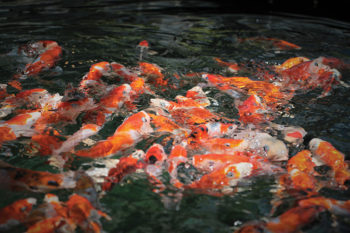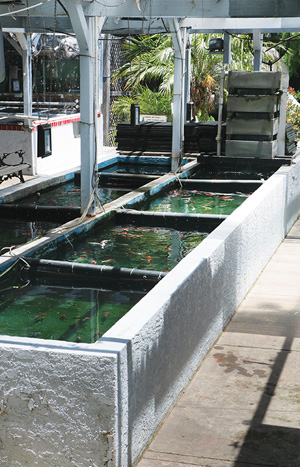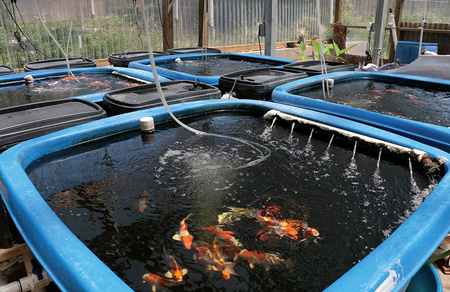
In the May/June 2018 issue, I wrote about how pond fish carry various good and bad “bugs” at all times. As I discussed, we cannot sterilize a fish or a pond to rid them of these bugs. Our efforts in pond health management should be focused on building the strength of the pond fish so that their natural immune system can deal with potential pathogens. Maintaining a clean pond and filter system with routine water changes results in a lower bug count in the pond. Likewise, any medicine we use is also an attempt to lower the bug count to a level where the fish can acquire natural immunity.
An established population of pond fish will acquire natural immunity to its own world of bugs. It is prudent to make sure the pond and filter are clean before adding new fish. Always treat the whole pond preventively with a good parasite-type medicine upon the introduction of new fish. This preventive medicine keeps the bugs in check and gives the fish a chance to develop a natural immunity to a low bug count. This hobbyist protocol should be followed regardless of any previous quarantine, no matter how thorough the quarantine might have been.
The aim of quarantining is to confirm and build the strength of new arrivals while treating for potential pathogens at the same time. A proper quarantine can take two to four weeks or more, depending on the temperature of the water. The quarantine tank needs to be sufficiently sized with established biological filtration so the fish are not exposed to the additional stressors of overcrowding and poor water quality. An inadequate quarantine tank can actually cause more weakness and stress instead of building the fish’s strength. That being said, proper quarantine should be the goal of every fish dealer before selling to the hobbyist.
[box style=”rounded”]>> Make sure to read Part 1, Language of Koi | Preventive Treatment for Koi Health, Part 1 from the 2018 May/June issue.[/box]
Salt Strategies

We have been importing Japanese koi for almost 30 years. We occasionally bring in domestic butterfly koi and have previously imported Israeli koi. In our facility, all new koi are kept separate from established koi and are housed in 900-gallon stock tanks with 150-gallon filter tanks. Koi are ideally stocked at three to five shipping boxes per 1,000 gallons. Koi from different farms are kept separate for two to three months. These tanks do not have any aquatic plants, and algae growth is minimal. One to two days before receiving the new koi, we remove all previous koi, clean the filters and make a 25 to 50 percent water change. We always add rock salt to between 0.5 to 0.6 percent, or 4 to 5 pounds per 100 gallons. The fish will remain in this salt level for a full two weeks, at which point we gradually reduce the salt back to zero with water changes.
Salt at 0.5 to 0.6 percent is the magic number. Maintaining this level of salt two weeks directly prevents the occurrence of parasites like Ichthyophthirius (“Ich”) and Chilodonella. But the main benefit of salt at this concentration is its role as a huge stress reliever. It helps the gills regain normal function. Excess mucus production in the gills is common in new arrivals due to the stress of shipping. This excessive mucus can interfere with the fish’s ability to respire and osmoregulate. Excess mucus in the gills is also a breeding ground for parasites like Trichodina and Costia and pathogenic bacteria, which feed on the mucus. The salt basically dries out the excess mucus, which helps to control some of these parasites.
During times of stress, the gills’ ability to osmoregulate is also impaired. The salt reduces the osmotic differential at the gills, which helps the fish to regain strength. Salt is not a cure-all, but it is a wonderful tool that, when used correctly, can be a great help to dealers in the controlled environment of their shops. This level of salt in a hobbyist’s pond could be disastrous if filled with aquatic plants and algae. Salt levels in ponds with aquatic plants or excess algae should never exceed 0.15 percent.
You will find that a 0.5 percent salt level is recommended in most Japanese books about koi disease. It must be noted that in the first few weeks of quarantine, we are using salt at 0.5 percent instead of a formalin-malachite green mixture, because the salt by itself treats many of the same parasites that the formalin-malachite green will treat. During the first 10 to 14 days, I am more concerned with the stress level of the koi and the function of the gills. It is not recommended to mix salt with formalin, because this combination can be too harsh. Keep in mind that neither the salt nor the formalin-malachite green will treat every possible bug, such as flukes. We always treat for flukes with a specific fluke medicine.
As with most things, you must decide which treatment is the most appropriate to use at the time.
Quarantine Protocol
The day of the new shipment, we adjust the pH to 7.0 before adding the fish. It should also be noted that the water temperature should be above 60 degrees, and preferably 65 to 75 degrees. For the first two days, the koi are kept covered, with lighting subdued. Just let them rest; do not feed them. Observe their behavior and check for mortalities.
 On the third day, inspect the koi more closely for outward signs of disease or pathogens, like raised scales, sunken eyes, listlessness, jumping or flipping, head or tail standing and fast gill movements. Typically we do not see many problems within the first three days, assuming the shipper did their part in preventive treatment. The koi are usually really hungry at this point, but I suggest light feeding. Odds are, they have gone without food since a few days before shipping, so their guts cannot take on a big load of food just yet.
On the third day, inspect the koi more closely for outward signs of disease or pathogens, like raised scales, sunken eyes, listlessness, jumping or flipping, head or tail standing and fast gill movements. Typically we do not see many problems within the first three days, assuming the shipper did their part in preventive treatment. The koi are usually really hungry at this point, but I suggest light feeding. Odds are, they have gone without food since a few days before shipping, so their guts cannot take on a big load of food just yet.
On the fourth and fifth days, we dose with Chloramine-T at 10 ppm. The dose depends on pH and hardness. Chloramine-T works well with the salt and will further reduce excess mucus on the body and in the gills. This helps bring down the bacteria count in the water and acts as a bit of a sanitizer. This treatment is optional, but it can be very helpful, and it helps enhance subsequent treatments. Slowly increase the amount of food, and monitor the water quality. Make sure to keep the koi on the hungry side during this period.
On Days 5 to 6, we dose with a fluke medicine. Gill and body flukes are very common and are resistant to medications. They must be treated again regardless of any previous treatments by the shipper. Praziquantel and flubendazole both work well. Light feedings should continue.
Between the seventh and 10th days, feeding can increase. Look over all the fish for disease. It’s extremely important to take mucus samples from several koi and study them under a microscope. By this time, a parasite that avoided the salt, Chloramine-T and fluke medicine will show up on the scope. If your salt was maintained between 0.5 and 0.6 percent, you should not see Ich or Chilodonella. However, you may still find flukes. Flukes will require a second dose during this period. If possible, take blood samples from each batch of koi and run a KHV ELISA test.
[box style=”rounded”]>> Related Content | Part 1, Preventive Treatment for Koi Health — Koi like stability in their environment. They get used to a certain set of water quality conditions and the existing microflora in the pond. This microflora includes non-pathogenic and pathogenic protozoa, algae, bacteria, viruses and fungi.[/box]
Note that parasites like Costia or Trichodina can be resistant to these medicines. These two potential pathogens are often considered commensal, meaning they are always present on fish but held in check by clean, stable conditions. They can grow out of control, especially in water temperatures below 65 degrees and in crowded, dirty water with low oxygen. If these parasites show up, correct any environmental problems and control this issue with potassium permanganate at 2 to 5 ppm.
Finally, during the last four days of the two-week period, treat with another dose of fluke medicine.
If your koi look good at this point, the preventive quarantine treatment is finished. Wait for the KHV tests to come back, and assuming the results are negative, you can release the fish for sale. The total quarantine period is typically three to four weeks.
Tips to Remember
If you choose to use a formalin-malachite green medicine instead of salt during the quarantine process, you must treat every two to three days, for a total of five treatments over the 10-to-15 day period. This will take care of the life cycle of Ich, which is very common. Both fluke medicines mix very well together with formalin-malachite green and create a “double whammy,” which can be very effective. You only need to dose twice with the fluke medicine (five to seven days apart) for prevention. If you have a bad fluke infestation, you can dose up to four times every three to five days, depending on temperature. Always know your gallons within 10 percent to treat effectively.

Never just assume your quarantine protocol is working. Always base your decisions on the condition of the fish and microscopic evaluation after daily observations. For example, if the fish are acting sick between the seventh and 10th days, you could have a fungal infection or a bacterial infection like columnaris. Either of these may be difficult to identify with the microscope, and symptoms can be confusing. The formalin-malachite green combination can be very helpful at treating bacteria and fungus.
These treatments and procedures have been very successful for me over the last 20 years. Rarely do we encounter problems with new fish, but we always stick to the protocol, no matter what.
There may be no one best way to quarantine your new pond fish, so develop a protocol that works for you and stick to it every single time. You can still make changes based on daily observations and your findings using your microscope. A good microscope will save you lots of money over time. If you don’t have one, get one. It does not have to be expensive to be useful.
Don’t let being too busy get in the way of your trusted protocol. The one time you let your guard down and hope everything will be OK is usually when you end up running into trouble. Never just go on luck. As I always say, “Fifty-percent odds are great in Vegas, but not with koi!”


